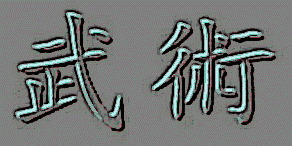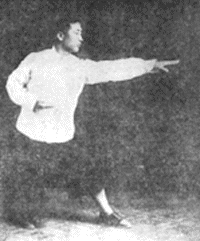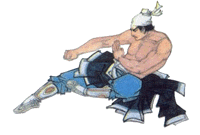

| Points
essentiels du Tongbiquan d'après Guo Chengyou (transmis par Guo Xianghe) |
English version | |
| Xu Yun | Gao Zhankui | Huang
Baoshan (en anglais) |

(Guo Chengyou 1895-1941)
1) L'origine légendaire du Tongbiquan
Sun Bing, (fameux
stratège de l'antiquité), lorsqu'il était installé
dans la région de Toumen, avait pour mission de surveiller un verger
de pêchers merveilleux. Ce pêcher avait des fruits qui poussaient
tous les dix ans en produisant chaque fois quarante-neuf pêches.
Sun Bing s'affairait chaque jour à se promener à travers
les arbres pour surveiller et compter les fruits, jusqu'à ce qu'un
jour, il ne s'aperçoive qu'un des fruit avait disparu. Très
surpris, il ne retrouva pas la pêche, jusqu'à ce qu'il revienne
le deuxième jour sur les lieux et qu'un deuxième fruit n'ait
disparu ! Le lendemain, à sa surprise et à son effroi, une
troisième pêche manquait aux arbres et Sun Bing décida
alors de dormir dans le verger pour trouver le voleur.
Le quatrième jour au matin, il fut réveillé par un
bruit au-dessus de sa tête, un grand singe blanc était en
train d'avaler tranquillement une pêche, assis sur une branche.
Sun Bing affaira alors une corde précieuse pour attraper le singe,
et il captura l'animal.
Il questionna le grand singe blanc sur ses origines, et il s'avérait
qu'il était d'origine céleste, et ainsi Sun Bing se lia
ainsi d'amitié fraternelle avec l'animal.
Sun Bing donna alors la recette de l'élixir d'immortalité
au grand singe, et le singe offrit les trois rouleaux manuscrits de l'art
du Tongbiquan comportant chacun huit techniques.
Le Tongbiquan a alors ainsi été transmis jusqu'à
aujourd'hui depuis cette période, et un poème ancien raconte
d'ailleurs à ce sujet " Le grand singe blanc enseigna le taoïsme
sans forme et sans ombre ainsi que les techniques subtiles du travail
interne. Il fit comprendre les cinq éléments, le yin-yang,
le bagua et leurs transformations au travers du corps "
2) Qigong, le travail du souffle
L'inspiration et l'expiration
sont les deux causes naturelles de ce qui nous rattache à la vie
et à l'univers, mais les techniques de respiration sont très
peu connues.
L'homme accompli à une respiration conforme à la nature,
et les deux actions d'inspirer et expirer doivent être utilisées
proprement, car quand l'air rentre dans le ventre c'est comme une nourriture
que l'on absorberait. Les organes internes se mettent en mouvement de
pair avec la respiration, et par conséquent, si celle-ci n'est
pas conforme, ils seront endommagés.
Si la respiration est parfaite, les organes internes seront en coordination
et les cinq éléments seront en harmonie.
C'est pour cela que les pratiquants d'arts martiaux s'exercent d'abord
au qigong, pour qu'ils puissent lier leurs fonctions internes d'une manière
à unifier le Qi. La méthode pour utiliser le Qi lorsque
le corps bouge, c'est de ne pas le laisser se disperser, car s'il est
dispersé, les pieds sont comme " sans racines ".
L'adepte qui est équilibré et calme a le Qi qui descend
et renforce par la base du corps, et ainsi, il a les mains souples et
les bras rapides lors de l'entraînement, puis lorsqu'il sort sa
force dans le combat, il dispose d'une grande puissance.
Il ne faut toutefois pas " forcer le Qi ", mais le laisser au
contraire sortir naturellement sans l'endommager et sans endommager son
corps, de manière à ce que l'attaque soit fulgurante, claire
et limpide.
La pratique du qigong dans le Tongbiquan et les arts martiaux en général
est la chose la plus importante, et l'adepte ne doit absolument pas négliger
cet aspect.
3) La puissance du cœur (et de la pensée)
Les personnes qui
ont un cœur fort et puissant ont les tendons et les os qui permettent
au Qi de circuler abondamment, ils ont le caractère calme et ils
utilisent la puissance de leur corps pour contrôler leurs souffles
(Qi). Leurs mouvements sont souples et rapides, leur corps est rond, leurs
mains ont un mouvement circulaire et ils sont redoutables et durs lors
du combat.
En haut, en bas, et dans les huit directions, ils peuvent frapper sans
problème, et les personnes qui sont arrivées à ce
niveau sont appelées des Maîtres.
Lors de la pratique, les mains sont horizontales ou verticales, puis la
force s'exprime par un mouvement " déchirant " dans les
six sortes de forces du Tongbiquan : frapper (da), charger (ji), appuyer
(an), surprendre (leng), claquer (tan), casser (cui). Toutes ses forces
sont différentes et difficiles à différencier, mais
le pratiquant du Tongbiquan doit savoir les Maîtriser lorsqu'il
frappe.
4) Les techniques de mains
Il y a beaucoup de
techniques de mains dans le Tongbiquan, mais il faut savoir bouger en
cercle avec les bras dans une optique circulaire. Attaquer de la main
(Yingshou) sert à diriger l'adversaire dans une position voulue
et ainsi saisir l'occasion de le frapper là où il ne s'y
attend pas.
On utilise en général huit sortes de forces d'attaques de
mains en Tongrien: Attraper (zhua), frapper (da), casser (cui), battre
(ji), appuyer (an) surprendre (leng), claquer (tan), rapide (kuai). Lorsque
l'on ramène la main, on utilise la force de l'adversaire pour :
crocheter (gou), accompagner (dai), transformer (hua), s'esquiver (dian),
cacher (cang).
On connaît à ce sujet le fameux poème du Tongbiquan:
"Ses mains sont
rapides comme des étoiles filantes, ses poings et paumes vont et
viennent incessamment, mais jamais vides. Il semble avoir des mains merveilleuses,
et en l'observant, nul ne peut percer les secrets de sa pratique.
Il lance un regard provocateur d'un côté pour venir frapper
de l'autre ; mais quel coup!
Ses épaules tournent et s'inclinent et ses bras suivent comme des
barres de fer, quand é son corps il est littéralement jeté
en avant. Quant il rencontre un adversaire, il a de multiples possibilités.
Ses deux mains sont rapides comme l'éclair et ses yeux sont clairs
comme de la foudre, extraordinaire que la pratique de ce poing.
En l'observant, ce n'est pas possible de ne pas voir que le Tongbiquan
est un poing de première qualité."
5) Les pas
Pas retourné
(daobu) et pas en cercle (quanbu) sont d'une grande mobilité. Si
l'ennemi attaque franchement en avant, je bondit à sa rencontre
pour l'attaquer. Si l'ennemi fait mine de reculer, j'utilise le pas chassé
(labu) pour le poursuivre. Si il semble arriver de côté,
j'utilise le 'pas contourné' (raobu) pour casser son attaque.
Si l'ennemi m'attaque férocement, je me replie avant de riposter.
Le poème dit à ce sujet :
" Faire les poings en crois (shizi pishan) en avançant sur
l'adversaire, et en attaquant de côté, frapper au milieu
avec force. Utiliser le 'vrai et le faux' (xu-shi) pour venir perturber
l'ennemi, puis utiliser le 'pas en cercle' pour encercler l'ennemi. Quand
tu attaques, bondit en avant en chargeant comme un tigre et quand il recule
ne lui laisse pas de répit, bouge, soit mobile et dirige le ou
tu veux, le vrai et le faux contiennent toute la subtilité.
6) Résumé général
La tête en
harmonie avec le cou, le cou en harmonie avec les épaules, les
épaules harmonie avec le coude, le coude en harmonie avec les côtes.
Les côtes en harmonie avec tout le bras, tout le bras en harmonie
avec la hanche, la hanche en harmonie avec les genoux, les genoux en harmonie
avec les mains. Les mains en harmonie avec les jambes, les jambes en harmonie
avec les yeux, les yeux en harmonie avec le cœur, le cœur en
harmonie avec les pas.
Les trois harmonies internes: cœur, courage, force. Les trois harmonies
externes: mains, yeux, pas. Le dos est rond, les deux bras s'écartent
comme des ailes, les deux mains rapides comme l'éclair, le bas
du dos décontracté, la poitrine vide et la force vers le
dantian.
7) Brèves notes biographiques
Guo Chengyao (Guo
Shutang) (1895-1941) est né dans la province du Heilongjiang tout
au nord de la Chine, et il commença son étude des arts martiaux
avec le style de l'aigle (yingzhao quanfa) qu'il étudia avec Maître
Chen Zizheng.
Il étudia aussi le Tongbiquan avec Wang Xialin, et son père
Wang Rupiao avant de transmettre un article "Points essentiels du
Tongbiquan " à son fils, GuoXianghe.
Guo Xianghe, né en 1939 a fait publié
le manuscrit dans le 101ème tome du magazine 'Wudang' en janvier
1999, et c'est celui-ci qui est traduit dans ce texte.
Essentials points
of Tongbiquan. By Guo Chengyou
(Transmitted by Guo Xianghe)

(Guo Chengyou 1895-1941)
1) The legendary origin of Tongbiquan
Sun Bing, (famous
strategist of antiquity), when it was installed in the area of Toumen,
had the role of supervising a garden of marvellous peach trees. This garden
had fruits which growed every ten years by producing each time fourty
nine peaches.
Sun Bing went every day to walk through the trees to supervise and count
the fruits, until one day, he realize that one of the fruit had disappeared.
Very surprised, he did not find the peach, until the second day that a
second fruit had disappeared ! The following day, a third peach missed
in the trees and Sun Bing then decided to sleep in the garden to find
the robber.
The fourth day in the morning, he was awaked by a noise above his head
when a large white monkey was swallowing a big juicy peach, satting on
a branch. Sun Bing used a magic roap then to catch the monkey, and he
captured the animal.
He questioned the large white monkey on its origins, and he proved that
he was of celestial origin, and thus Sun Bing thus bound fraternal friendship
with the animal.
Sun Bing then gave the receipt of the elixir of immortality to the gibbon,
and the monkey offered the three secret rolls manuscripts of the art ofTongbiquan
comprising each one eight techniques.
"The large white monkey taught the taoism without form and shade
as well as the subtle art of internal work. He made understanding the
five elements, the yin-yang and their transformations through the body"
2) Qigong, the work of breathing
The breathin and breathout
are the two natural causes of what attaches us to the life and the universe,
but the techniques of breathing are far from known.
The achieved man with a good breathing is in conformity with nature, and
the two actions to inspire and expire must be used properly, because when
the air returns in the stomach it is as a food which one would absorb.
The internal body organs put themselves moving of pair with breathing,
and consequently, if this one is not in conformity, the inner organs will
be damaged.
If breathing is perfect, the internal body will be of coordination and
the five elements will be in harmony.
It is for that that the practisers of martial arts are exerted initially
with the Qigong exercises so that they can bind their internal functions
in a manner to unify the Qi. The method to use the Qi when the body moves,
it is not to let it disperse, because if it is dispersed, the feet are
like "without roots". The follower who is balanced and calm
have the Qi which goes down and
reinforces by the base of the body, and thus, it has flexible hands and
fast arms at the time of training, then when it leaves its force in fighting,
he has a great power.
The Qi should not however "be forced", but to let it on the
contrary leave naturally without damaging it and damaging the body, so
that the attack is fulgurating, clear and limpid.
The practice of Qigong in Tongbiquan and the martial arts in general is
the most important thing, and the follower should not absolutely neglect
this aspect.
3) Power of the heart (and of the thought)
The people who have
a powerful heart have the tendons and the bones which make possible to
the Qi to abundantly circulate in the body, they are calm and they use
the power of their body to control their breaths (Qi). Their movements
are flexible and fast, their body is round, their hands have a circular
motion and they are frightening and hard at the time of fighting.
In top, in bottom, and in the eight directions, they can strike without
problem, and the people who arrived at this level are called Masters.
At the time of practice, the hands are horizontal or vertical, then the
force is expressed by six kinds of forces: to strike (da), to charge (ji),
to press (an), to surprise (leng), to slap (tan), to break (cui). All
its forces are different and difficult to differentiate, but the practitioner
of Tongbiquan must know to them when it strikes.
4) Techniques of hands
There are many techniques
of hands in Tongbiquan, but it is necessary to know to move in circle
with the arms from a circular point of view. To "attack with the
hands" (yingshou) is used for directing the adversary in a desired
position, and thus seizing the occasion to strike it where it does not
expect it.
One in general uses eight kinds of forces of attacks in the hands in Tongbiquan:
To catch (zhua), to strike (da), to break (cui), to beat (ji), to press
(an) surprise (leng), slap (tan), fast (kuai). When the hand is brought
back, one uses the force of the adversary for: To hook (gou), to accompany
(dai), to transform (hua), to dodge itself (dian), to hide (cang).
One knows on this subject the famous poem of Tongbiquan:
"His hands are
fast like shooting stars, his fists and palms go and come without delay,
but never empty. It seems to have marvellous hands, and by observing it,
nobody can understand the secrecies of its art.
He launches a provocative glance on a side to come to strike other; but
what a strike!
His shoulders turn and are inclined and his arms follow like iron bars,
when his advancing, his body it is literally thrown ahead. As it meets
an adversary, he has multiple possibilities. His two hands are fast like
the flash and its eyes are clear like the lightning, extraordinary that
practice of this fist technique. By observing it, it is not possible not
to see that Tongbiquan is a fist of the first quality."
5) Steps
The 'step to turn
over' (daobu) and the 'ring step' (quanbu) are of a great mobility. If
the enemy attacks frankly ahead, I meet him in front. If the enemy makes
mine to move back, I use the step driven out (labu) to continue. If it
seems to arrive on side, I use the 'side step' (raobu) to break his attack.
If the enemy attacks me savagely, I fold up myself before counteracting.
The poem called on this subject:
"Make the 'crossing forearms fist' (shizi pishan) while advancing on the adversary, and by attacking side, strike in the middle with force. To use ' truth and false' (xu-shi) is for to come and disturb the enemy, then to use the 'encercling step' to encircle the enemy. When you attack, leaps ahead while charging like a tiger and when he moves back, do not leave him respite, move, either mobile and direct him where you want, the truth and the false attacks contain all the subtlety.
6) General Summary
The head harmonizes
with the neck, the neck harmonizes with the shoulders, the shoulders harmonizes
with the elbow, and the elbow harmonizes with the coasts. The coasts harmonizes
with all the arm, all the arm harmonizes with the hip, the hip harmonizes
with the knees, and the knees harmonizes with the hands. The hands harmonizes
with the legs, the legs harmonizes with the eyes, the eyes harmonizes
with the heart, and the heart harmonizes with the steps.
Three internal harmonies: heart, courage, force. Three external harmonies:
hands, eyes,steps. The back is round, the two arms moving like wings,
two fast hands like the flash, the bottom of the back is relaxed, the
chest is empty and the force towards the dantian.
7) Short biographical notes
Guo Chengyao (Guo
Shutang) (1895-1941) born in the province of Heilongjiang began its study
of the martial arts with the style of the eagle (Yingzhao quanfa) which
he studied with Master Chen Zizheng, the "king of the eagle claw".
He studied also Tongiquan with Wang Xialin, and her father Wang Rupiao
before transmitting an article "Essential of Tongbiquan fist"
with his son, GuoXianghe.
Master Guo Xianghe, born in 1939 made published the
manuscript in the "Wudang" magazine in January 1999, and it
is this one which is translated in this text.
